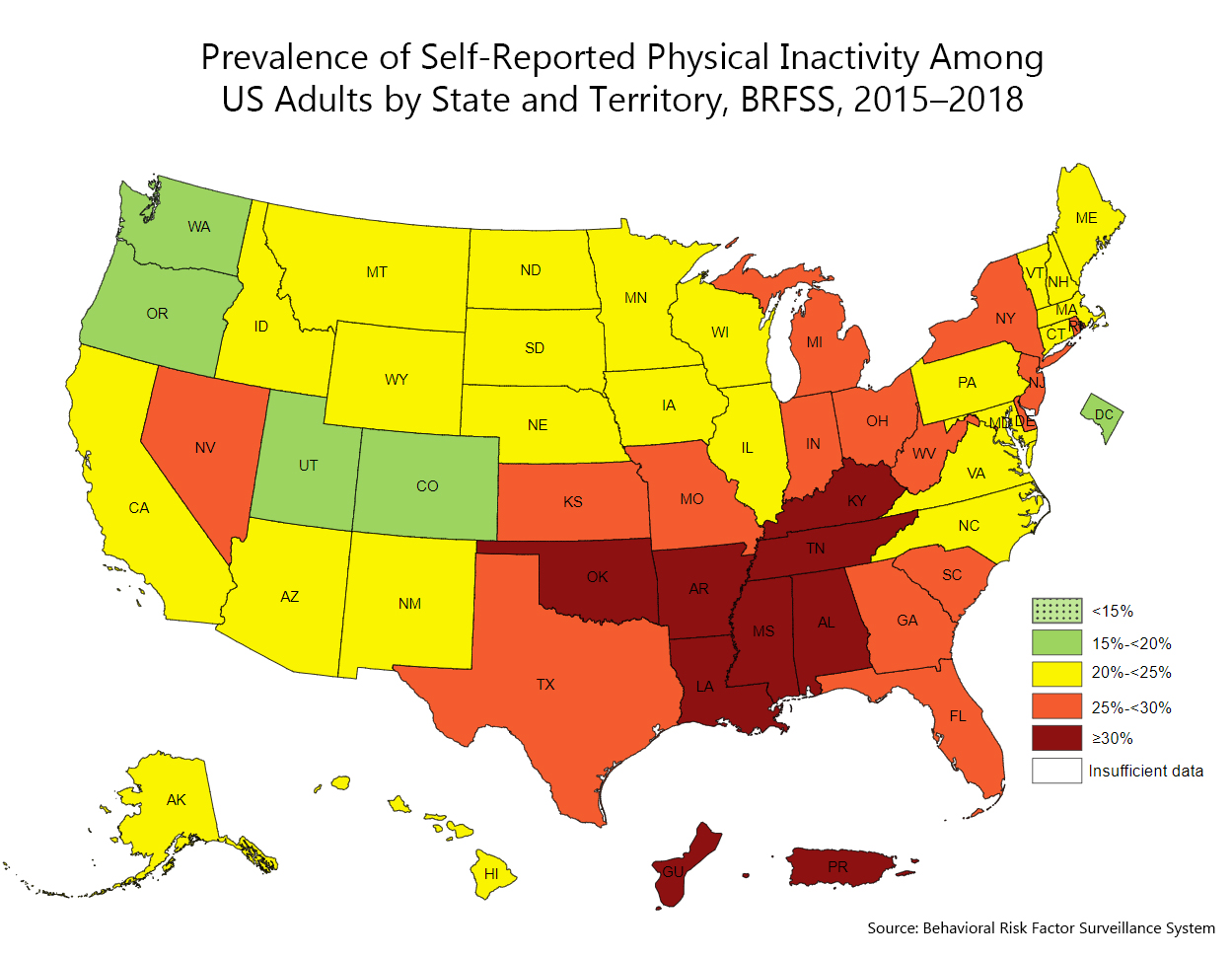January 16, 2020
3 min read
 This article is more than 5 years old. Information may no longer be current.
This article is more than 5 years old. Information may no longer be current.
CDC: More than 15% of US adults physically inactive
More than 15% of adults in every U.S. state and territory are physically inactive, according to new CDC data.
“Too many adults are inactive, and they may not know how much it affects their health,” Ruth Petersen, MD, director of CDC’s Division of Nutrition, Physical Activity and Obesity, said in a press release. “Being physically active helps you sleep better, feel better and reduce your risk of obesity, heart disease, type 2 diabetes and some cancers.”
The CDC released state maps showing the prevalence of physical inactivity in the U.S. based on 2015-2018 data from the Behavioral Risk Factor Surveillance System. Their findings included the following:
- By state, Colorado had the lowest prevalence of physical inactivity at 17.3%; Puerto Rico had the highest at 47.7%.
- By U.S. region, the South had the highest prevalence of physical inactivity at 28%; the West had the lowest prevalence at 20.5%.
- By race, Hispanics had the highest prevalence of self-reported physical inactivity at 31.7%, followed by non-Hispanic blacks at 30.3% and non-Hispanic whites at 23.4%.
Inactive lifestyles contribute to one in 10 premature deaths in the U.S. and $117 billion in annual health care costs, according to the CDC. The agency pointed to the Physical Activity Guidelines for Americans, which recommend that adults get at least 150 minutes of moderate-intensity physical activity each week, such as briskly walking, bike riding or taking the dog for a walk. That time can be broken into smaller amounts, such as 25 minutes each day or 30 minutes five times a week.
“The key is to move more and sit less,” the agency said.
Disclosure: Petersen reports no relevant financial disclosures.
Perspective
Back to Top
Dennis Bruemmer, MD
These findings from the CDC are not surprising and may even be underestimated, since other data show that less than half of the U.S. population meets the recommended physical activity guidelines. Many of these same people spend 11 hours in front of a TV, computer or other screen daily, and one-third of them eat at fast food places daily. Compounding these statistics is that there is a poor understanding among U.S. adults of how sick of a nation we truly are.
To try and reverse these trends, physicians should educate their patients about the risks associated with poor food choices, lack of exercise and other modifiable risk factors. Physicians can also encourage participation in supervised weight management programs and physical activity programs. There will be challenges in getting patients to do these things, but we must get them to do these things, because so many of the consequences of an inactive lifestyle — prediabetes, diabetes, CVD and many cancers — are preventable.
Dennis Bruemmer, MD
Preventive cardiologist and endocrinologist
Director of Cardiometabolic Center, Cleveland Clinic
Disclosures: Bruemmer reports no relevant financial disclosures.
Perspective
Back to Top
Sajani Shah, MD
These findings run parallel to some of the socioeconomic features of the areas studied. For example, cities typically have large proportions of their populations that walk to a lot of the places they need to go: to work, to the gym, to school, etc. Therefore, cities will always have higher physical activity rates. Conversely, in rural areas, people have to drive just about everywhere they have to go and thus, they do not get this same type of physical activity. Consequently, their physical activity rates are generally lower.
The best advice I can give primary care physicians to help their patients meet the physical activity guideline is to tell patients that they do not have to join a gym and spend hours there each day to lose weight. Instead, advise patients that there is so much data that suggest breaking the recommended time limit (150 minutes weekly) into 10- to 15-minute intervals throughout the week adds up and also counts towards the guideline. Tell them to take the stairs instead of the elevator. Tell them if it’s too cold or too hot outside to do a brisk 20-minute walk, tell them to head to a climate-controlled mall. Tell them to forgo hiring a dog walker and walk the dog themselves. Most patients will find enough such activities in their daily routine that they meet the requirement and never thought of it as exercise.
Sajani Shah, MD
Chief, minimally invasive and bariatric surgery
Tufts Medical Center
Disclosures: Shah reports no relevant financial disclosures.



